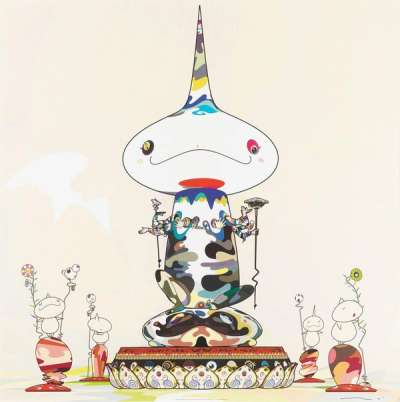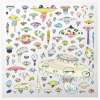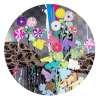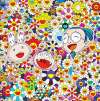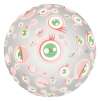Mr
Pointy
This collection features lithographs by Takashi Murakami starring his cartoon character, Mr. Pointy, whose name fairly describes his round face and pointy head. Murakami has stated that the ‘spire-like’ point acts as ‘a communication centre with outer space’; thus, the character's embodies all of Murakami’s varied influences: futuristic, Buddhist and anime-related.
Takashi Murakami Mr Pointy For sale
Mr Pointy Value (5 Years)
Sales data across the Mr Pointy series by Takashi Murakami varies by print. While standout works have sold at auction for up to £1200, other editions in the series remain rare to market or have yet to appear publicly for sale. Of those tracked, average selling prices have ranged from £849 to £849, with an annual growth rate of 3.62% across available data. Collectors should note the discrepancy in performance between more visible and lesser-seen editions when considering value potential in this series.
Mr Pointy Market value
Auction Results
| Artwork | Auction Date | Auction House | Return to Seller | Hammer Price | Buyer Paid |
|---|---|---|---|---|---|
 Reversed Double Helix Takashi Murakami Signed Print | 28 Jan 2024 | SBI Art Auction | £723 | £850 | £1,000 |
 Reversed Double Helix Mega Power Takashi Murakami Signed Print | 22 Nov 2021 | Christie's Hong Kong | £723 | £850 | £1,150 |
Sell Your Art
with Us
with Us
Join Our Network of Collectors. Buy, Sell and Track Demand
Meaning & Analysis
The Mr Pointy collection is composed of three lithograph prints, all of which were produced by the contemporary Japanese artist, Takashi Murakami in 2005. The prints all come in edition sizes of 300, as is common for most of Murakami’s prints.
The prints in this collection all feature Murakami’s cartoon character, Mr. Pointy. The cartoon is identifiable by his round face and pointy head, which has been described as ‘spire-like’. The character has two small round eyes and Murakami uses a thin black line to draw the character’s mouth. Speaking about Mr. Pointy’s head, Murakami has stated that the point acts as ‘a communication centre with outer space’. Mr. Pointy’s appearance combines Buddhist and animism iconography as well as influences from anime and manga (Japanese cartoons and comics). The character is infused with historical influences, however the pointed head and its function to communicate with outer space means he also has a futuristic edge. In this cartoon character, Murakami fuses the past and future, the ancient and the contemporary.
Mr. Pointy’s fusion of old and new resonates strongly with Murakami’s artistic style which combines traditional Japanese artistic conventions with contemporary styles and popular culture. Murakami studied ‘nihonga’, a traditional Japanese painting style at the Tokyo University of Fine Arts and Music. Not only did Murakami complete his BA there, he also went on to do a Master’s and PhD, specialising in this traditional art form. Murakami soon became disillusioned with the insular and political art world, and after spending a year in New York in 1994, where he was exposed to the works of contemporary Western artists, like Jeff Koons and Anselm Kiefer, he began experimenting with more contemporary artistic styles.
As well as being influenced by his time in New York, Murakami’s artistic style is deeply marked by his interest in anime, manga and Japanese popular culture. Murakami’s visual language takes elements from the ‘otaku’ subculture, which is rooted in computers and nerd culture, as well as ‘kawaii’ culture, the culture of cuteness which is very popular in Japan. The subcultures and popular culture influences that permeate Murakami’s work are traditionally considered to be part of Japan’s ‘low’ culture. Murakami’s incorporation of these cultures, however, means he is able to blur the boundary between ‘high’ and ‘low’ culture and elevate the popular to the realm of fine art.
